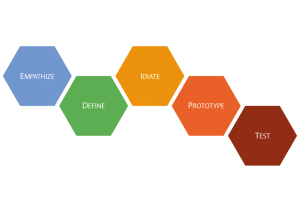Kategorie: ‘General’
What is design thinking?
In my first post I would like to share with you what design thinking means to me.
When people ask me what design thinking is, I usually encounter one major problem: design thinking is by no means defined, so the term might have different meaning depending on the person you talk to. So what I will tell you about design thinking might be something completely different to what, let’s say an SAP manager will tell you. Having said this, there is an excellent study on design thinking in organizations that has been published recently, which also looks at its understanding and application. It’s called Parts without a whole (Schmiedgen et al., 2015) and was conducted by scholars from the Hasso-Plattner-Institut, Potsdam. I will try to wrap up the relevant sections for you:
Design thinking is usually seen as an iterative process for problem solving. This process particularly focuses on empathizing with users and thereby helps to develop human-centered products or services. It also helps to organize collaboration. Lots of people also regard design thinking as a mindset, advocating exploration, ambiguity, optimism and future-orientation (Schmiedgen et al., 2015; Hassi & Laakso, 2011).
I am aware that this summarization sounds like just another string of buzzwords. In fact, it scores a whooping .94 on the BlaBlaMeter – how much bullshit hides in your text?. So let’s dig deeper into how design thinking is actually used.
To understand this, it is helpful to distinguish between mindsets, methods and tools, all of which can be linked to design thinking. While mindsets are very abstract and hard to obtain, methods are easier to work with. Tools even more so.
So what methods are used to do design thinking? To me, it all boils down to four major methodological approaches:
Diverse collaboration: It is very helpful to solve problems in diverse teams. Team members can bring different competences to the table and – even more important – will scrutinize convictions of their team mates, which will lead to reasoned results. People who use design thinking will often use whiteboards and post-its as tools to support and foster collaboration, e.g. during brainstorming sessions or to keep track of their project’s process.
User-centeredness: Almost all the problems we are solving in today’s world have one or more human beings as stakeholders (we probably would not try to solve it elsewise). Typically we are developing a product or service for a user. To do this, design thinkers often interview and observe users in their everyday life or – later on – using a prototype of solutions they came up with.
Prototyping: Design thinking is an iterative process, where solutions are constantly improved to get to the final product. Therefore, it is helpful to use prototypes to understand user needs and the feasibility of solutions one comes up with.
Five-step iterative process: Finally, design thinking is often taught as a five-step iterative process, for example at the d.school, Stanford University. This is used as a framework for less experienced design thinkers.
Now, a lot of people (including me) will argue that the usage of tools and methods that link to design thinking does not mean you are design thinking. In fact, I would even argue that design thinking is possible without using any of its particular methods or tools, namely just by applying a design thinking mindset to a problem. But in order to understand and practice design thinking as a mindset, methods and tools are a very helpful starting point! They will foster the design thinking mindset, meaning that they encourage exploration, ambiguity seeking, optimism and future-orientation (taken from my bullshit paragraph above…).
So to wrap it up, design thinking is not so much a methodology but rather a mindset that helps finding great solutions to problems. Nevertheless, to get started with design thinking it helps to use certain methods and tools, which foster and support the particular mindset we are looking for.
P.S.: If you are looking for a description of “design thinking methods”, you can find a good overview here: DesignKit by ideo.org.
Hassi, L., & Laakso, M. S. (2011). Conceptions of design thinking in the management discourse. Proceedings of the 9 Th European Academy of Design (EAD), Lisbon.
Schmiedgen, J., Rhinow, H., Köppen, E., & Meinel, C. (2015). Parts Without a Whole? – The Current State of Design Thinking Practice in Organizations (Study Report No. 97) (p. 144). Potsdam: Hasso-Plattner-Institut für Softwaresystemtechnik an der Universität Potsdam. Retrieved from http://thisisdesignthinking.net/why-this-site/the-study/
Graphics based on works by Lil Squid, Yazzer Perez, and Chris Gregory from The Noun Project.





